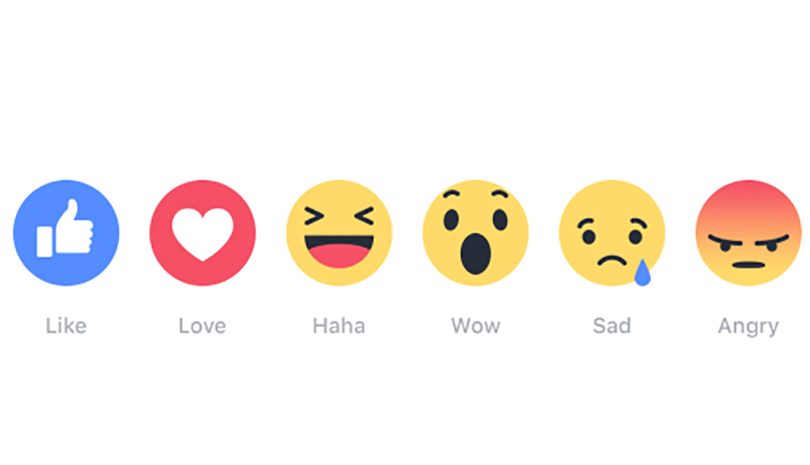Why retailers should love Facebook Reactions

About 12 months ago I wrote about how brands shouldn’t react to Facebook Reactions, and said to watch this space.
Why? Because at the time Facebook were still supporting “engagement” on their algorithm, it was only 2 weeks after Facebook had finally released something beyond “like” and reactions were a learning space for Facebook.
So, after watching this space and about 12 months later, the stats on Facebook’s treatment of Reactions and the impact on the algorithm are finally in!
Facebook has decided that loving a post is more important than liking a post. In fact, they have decided that all reactions (angry, haha, sad and wow included), are now more valuable than everyone’s favourite blue-cuffed thumbs up.
Yes, finally reactions will be prioritised above a simple like and we can’t say we didn’t see it coming, we just weren’t sure when it would happen and what the decisions would be.
In a bid to continually improve their algorithms, Facebook has announced they plan to rank posts with ‘reactions’ above those with ‘likes’. Here are some possible reasons behind the decision:
● Data: a company of Facebook’s size doesn’t make any decision without data in mind. Facebook found that reacting to a post took more time and effort than simply clicking like. For example, mobile users need to hold down the like button to access the reaction options and for desktop users the reactions aren’t available until you hover over the like button. Those extra seconds taken to create a reaction are incredibly valuable to Facebook who are always looking to improve user engagement
● Emotion economy: Facebook founder Mark Zuckerberg has continually pressed the point that Facebook is a platform for free speech and social inclusion. Valuing the emotions of users above the other aspects of the algorithm filter shows Facebook means to continue this plight. Just because you react angrily to content it doesn’t mean you’ll see less of it, all reactions will be weighted equally. This will keep social discussion open and allows for all parties to have an input in a way that is both incredibly simple, but very meaningful. Facebook’s Pride Month rainbow flag reaction is a great example of this!
● Possible advertiser benefits: Although nothing has been announced, it is possible that Facebook plans to eventually use this feature to help advertisers create reaction driven campaigns. For example, users who have reacted with the ‘love’ or ‘haha’ reactions three times in a morning could be perceived as being in a positive mood. Good mood = more likely to click on an ad and make a purchase. We will need to keep an eye on Facebook to see what they do in the near future and report back to advertisers.
That brings me to my next point. Just as the reactions will impact publisher and individual user posts it will also have a great impact on advertising content.
Creating great content to encourage your followers to like and share your posts is a given on Facebook and many social content marketers have mastered the art. Encouraging them to spend those extra seconds reacting? Now that could be a challenge.
Advertisers know how to cash in on human emotions, it’s their job. So until further targeting features are released here’s how marketers can use Facebook reactions.
1. Tune into customer emotions: We humans are more emotional then we are logical, psychologists have known that for decades. What motivates the emotions of your customers? Are they politically driven? Do they ‘love’ cute cat videos? Or maybe they engage with heart wrenching videos of people overcoming disasters? You can easily create reports based of reaction numbers on past Facebook posts and use this information to inform future posts. Promoting reactions is not a matter of manipulating emotion, it should be used to help you empathise ad or content that connect with users on a emotional level.
2. Reaction-based feedback: What better way to survey your followers response to a product or service then to simply ask how they feel about it? Interpreting reaction data is far more revealing than vanity metrics like ‘number of likes’ as a like doesn’t give you the option to criticise, nor a scale of emotion. Reactions have also been used to create interactive polls on Facebook where you directly ask for a specific reaction that is associated with an answer.
3. . Data collection: Leading marketers have found ways to collect and interpret all kinds of data points that reveal various customer behaviours. Interpreting the emotions that drive those behaviours is the tricky part. Facebook reactions make this a little easier! Reaction numbers and type will allow you to scale customer behaviour against emotional state which will give you a great insight into what emotions drive buying behaviour in your customers.
The reasons above are why us digital marketers shouldn’t ‘like’ Facebook reactions, we should ‘love’ them! It’s all a matter of knowing how to use them.
Alita Harvey-Rodriguez is a leading Australian Digital Marketing Futurist and the brains behind Milk it Academy.
Comment Manually
You must be logged in to post a comment.

No comments